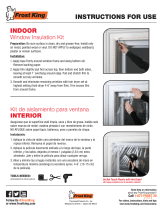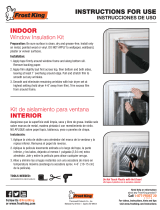¡ADVERTENCIA!
SU ÁREA DE SECADO
■ Mantenga el área debajo y alrededor de
sus electrodomésticos libre de materiales
combustibles (pelusas, papel, trapos, etc.),
gasolina, productos químicos y otros líquidos
y vapores inflamables.
■ Mantenga el piso alrededor de sus
electrodomésticos limpios y secos para reducir
la posibilidad de un accidente.
■ Supervise a los niños en caso de que ellos usen
la secadora o jueguen cerca de ella durante su
operación. No permita que los niños jueguen con
la secadora, en su interior, sobre ella o ningún
otro electrodoméstico.
■ Mantenga todos los artículos de limpieza
(tales como detergentes y blanqueadores) fuera del
alcance de los niños, preferiblemente encerrados
en un gabinete. Ponga atención a las advertencias
en las etiquetas de los envases para evitar
accidentes.
■ Nunca trepe ni se ponga de pie sobre la parte
superior de la secadora.
CUANDO USE SU SECADORA
■ Nunca introduzca sus manos en el interior de
la secadora mientras el tambor giratorio esté
moviéndose. Antes de agregar y sacar ropa, espere
hasta que el tambor giratorio se haya detenido.
■ Limpie el filtro de pelusas antes de cada carga
para evitar la acumulación de pelusas en el interior
de la secadora o en la habitación. NO OPERE LA
SECADORA SIN EL FILTRO DE PELUSAS EN SU
LUGAR.
■ No lave o seque artículos que se hayan limpiado,
lavado, remojado o salpicado con sustancias
combustibles o explosivas (tales como cera, aceite,
pintura, gasolina, desengrasadores, solventes de
tintorería, kerosene). Estas sustancias producen
vapores que podrían incendiarse o explotar. No
agregue estas sustancias al agua de lavado. No
use ni coloque estas sustancias alrededor de la
lavadora o secadora durante su uso.
■ No coloque artículos expuestos a aceite
de cocinar en la secadora. Los artículos
contaminados con aceites de cocinar podrían
contribuir a formar una reacción química que
podría causar que una carga de ropas se incendie.
■ Cualquier artículo sobre el cual usted usó
un solvente de limpieza o que contenga materiales
inflamables (tales como paños de limpieza,
trapeadores, toallas usadas en salones de belleza,
restaurantes o barberías) no se deben colocar en el
interior o en las proximidades de la secadora hasta
que los solventes o líquidos inflamables se hayan
removido. Existen muchos artículos inflamables
en el hogar tales como la acetona, el alcohol, la
gasolina, el kerosene, algunos limpiadores, algunos
quitamanchas, aguarrás, trementina, ceras,
removedores de cera y productos que contengan
derivados del petróleo.
■ El proceso de lavado puede reducir la habilidad
de retardar la flamabilidad de algunas telas.
Para evitar tal resultado, siga las instrucciones
del fabricante de las telas con mucho cuidado.
■ No seque artículos que contengan goma, plástico,
espuma o materiales similares tales como sostenes
(brasieres) con relleno, ganchos de goma,
alfombras de baño, baberos de niño, pantalones de
niño, bolsas plásticas y almohadas que se puedan
derretir o quemar. Algunos materiales gomosos,
cuando se calientan, bajo ciertas circunstancias
podrían incendiarse por combustión espontánea.
■ Durante su operación, no almacene encima de la
secadora plásticos, papel o ropa que se puedan
quemar o derretir.
■ Las prendas de vestir etiquetadas “Dry away
from heat” (Secar alejadas del calor) o “Do not
tumble dry” (No secar por giro)—tales como
chaquetas salvavidas que contienen Kapok—
no se deben colocar en su secadora.
■ No seque artículos de fibra de vidrio en su
secadora. Esto podría ocasionar irritación en la piel
debido a las partículas restantes que se podrían
adherir a la ropa durante usos subsecuentes
de la secadora.
■ Para minimizar la posibilidad de una descarga
eléctrica, desconecte éste electrodoméstico de su
tomacorriente o desconecte la secadora del panel
de distribución eléctrica del edificio removiendo el
fusible o desconectando el circuito antes de dar
cualquier tipo de mantenimiento o limpieza (con
la excepción de remover y limpiar el filtro de la
pelusa). NOTA: accionar la perilla Selectora de ciclo
a una posición de apagado (Off) o apretar PAUSE
(PAUSA), NO desconecta el electrodoméstico de la
fuente de alimentación eléctrica.
3
Solución a problemas comunesInstrucciones de operaciónInstrucciones de seguridad





















